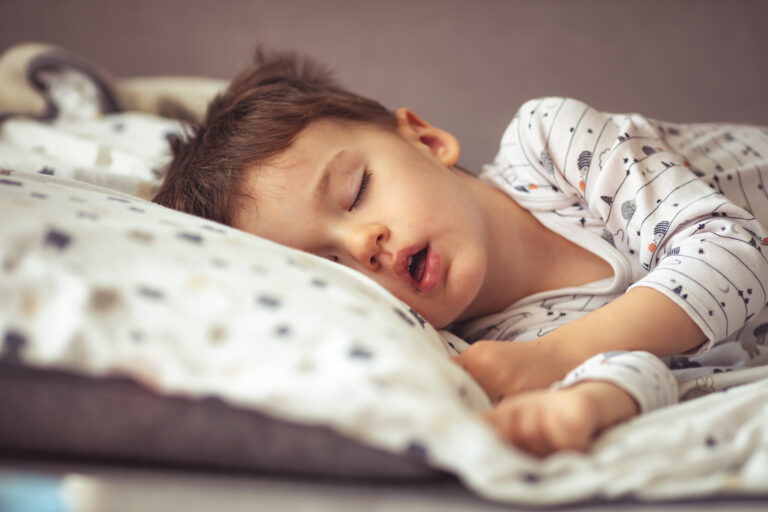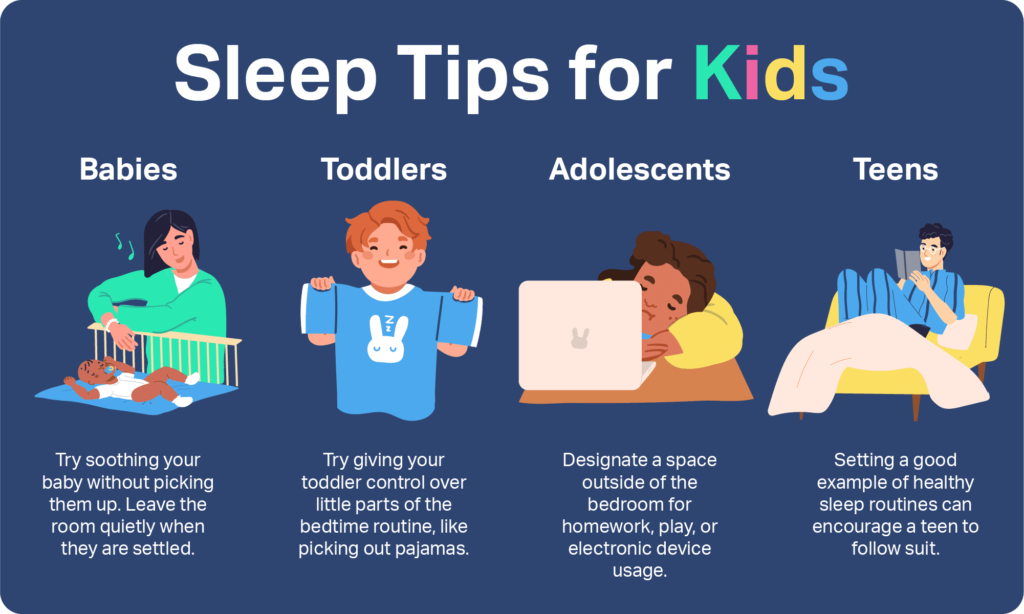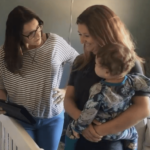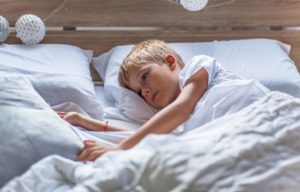When you buy through our links, we may earn a commission. Products or services may be offered by an affiliated entity. Learn more.
Bedtime Routines for Children
- Bedtime routines are vital for a child’s sleep quality and quantity.
- Consistency and encouragement can help children maintain an ideal sleep schedule.
- Calming activities and easy-to-follow routines can reduce bedtime struggles in kids.
Getting quality sleep is essential in childhood, yet research shows that as many as
20 to 30%
of babies and toddlers have trouble sleeping. If you’re the parent or caregiver of a young insomniac, you’ll know firsthand how frustrating it is to see your little one struggle with bedtime.
One of the easiest ways to set your child up for good sleep is by creating a bedtime routine. The good news is that it only takes a
few nights
of following a bedtime routine to see improvements in your child’s sleep.
Help Your Child Sleep Better With Pediatric Sleep Coaching

our partner at sleepdoctor.com
Learn More“Life-changing! My anxiety about my son’s sleeping habits were immediately reduced after talking to Sara. She went above and beyond to tailor a schedule to our goals, answer our questions, keep us on track, and check in to encourage us when we just thought we couldn’t do it anymore.”
Rachael B. – Verified Customer
What Is a Bedtime Routine, and What Are the Benefits?
Bedtime routines are a consistent, repetitive set of activities that are carried out before bed every night. They help prepare your child for sleep by having them relax and wind down. A predictable routine also gives your child a sense of security and teaches them how to fall asleep on their own.
Research shows that children who follow bedtime routines are more likely to go to sleep earlier, take less time falling asleep, sleep longer, and wake up less during the night. These benefits to sleep quality are still seen years later in children who followed bedtime routines when they were younger.
In addition to improving sleep, bedtime routines teach your child self-care and lay the ground for working memory, attention, and other cognitive skills . They also foster parent-child bonding and may help improve mood, stress levels, and behavior.
In the long term, these benefits translate to better readiness for school, as well as better academic performance and social skills. By contrast, those who don’t follow a bedtime routine in childhood are more likely to have sleep problems and be overweight during adolescence .
Setting a bedtime routine right from the beginning with your baby makes it easier to keep up healthy habits as your child grows.

How To Build a Bedtime Routine for Kids
A bedtime routine for kids usually consists of three or four activities, for example, having a snack, brushing teeth, putting on pajamas, and reading a book. These should always be done in the same order. To make the routine even more effective, start winding down the household by dimming the lights and turning off screens in the lead-up to bed.
Typical bedtime activities that have been shown to have beneficial effects on sleep include:
- Nutritious snack or bottle/breastfeeding
- Bath or diaper change
- Brushing teeth and going to the bathroom
- Reading a book
- Lullaby or singing a song together
- Massage, cuddling, and rocking
- Talking about their day
The bedtime routine should culminate in a goodnight kiss and lights-out. You should leave the room while your child is sleepy but not asleep yet. This way they learn to fall asleep on their own, and they won’t panic if they wake up in the middle of the night and find you gone. Set a consistent bedtime that leaves enough time for your child to sleep the recommended amount of hours for their age.
Bedtime Dos and Don’ts
Certain activities are counterproductive to sleep and may cause your child to form unhealthy habits. Of course, every child is different and you may find it takes some trial-and-error to find out what works best for your family. However, when crafting your child’s bedtime routine, try to stick to the following advice:
Do:
- Do it every day: A nighttime routine for kids should consist of the same steps every night , or as many nights as possible . To get all the benefits, it’s important for both parents to participate in the bedtime routine where possible.
- Keep it short and sweet: For most children, a bedtime routine should last around half an hour, or a little longer if there’s a bath included. Prolonging the routine can delay bedtime and makes it harder to implement on days when you’re short on time.
- Keep it up during the day: Following a routine during the day, including setting clear limits, leads to increased sleep duration for young children. Getting lots of exercise, sunlight, and outdoor time during the day can also help them sleep better at night.
- Listen to your child: Although you’re ultimately in charge, it’s not a bad thing to leave your child some liberty. If a part of the bedtime routine isn’t working for your child, listen to their concerns and adapt the routine if necessary.
- Follow sleep hygiene rules: Keep the bedroom dark, cool, and quiet to promote sleep. If your child is scared of the dark, you can use a dim nightlight. Even after bedtime, noise levels in the rest of the house can keep young children awake , so try to transition to quieter activities once you’ve tucked the kids in.
- Make gradual changes: Try not to introduce more than one change at a time to the bedtime routine, and consider delaying these if there are other changes going on, such as moving to a new house or starting school. As your child’s sleep needs change, shift bedtime by 15-minute increments each night.
Don’t:
- Start when they’re already sleepy: Overtired children can be hyperactive or grumpy and will find it even harder to fall asleep, so try to start the routine before they start yawning.
- Let them use screens: The blue light from television and other electronic devices has serious consequences for sleep if used too close to bedtime.
- Let them run around: Your child should have plenty of opportunities to burn off steam during the day, but don’t let them work themselves into a frenzy at night or they’ll be too wired to sleep.
- Give sugary treats or caffeine: Try to keep evening snacks light and healthy. Caffeine will keep kids awake, and sugary treats before bed can lead to cavities . Breakfast cereals, chocolate, and pudding can be sources of caffeine you may not expect. If your baby is bottle-feeding, remove the bottle before they fall asleep.
- Read scary bedtime stories: Avoid scary stories and other mentally or physically stimulating activities before bed.
- Let them sleep in on weekends: It’s tempting to catch up on sleep on non-schooldays, but straying more than an hour from the usual wake-up time can actually cause trouble falling asleep on weekdays .
Bedtime Tips for Toddlers, Kids, and Teens
It’s natural to adapt bedtime routines as your child grows .
In early childhood, many toddlers are gripped by the throes of separation anxiety. This is a good time to introduce a stuffed animal or comfort blanket for extra reassurance when you leave the room.
Toddlers will also try to assert their newly found independence by acting out or resisting bedtime. You can head off their stalling tactics by letting them make some of their own decisions, such as what pajamas to wear or which book to read. You may need to exert some creativity to make the bedtime routine more fun. When it’s time for lights-out, calmly and firmly bid them goodnight, and leave the room.
Once children hit school age, they’re ready to take on more responsibility. Encourage them to take an active part in the bedtime routine by brushing their own teeth and tidying up their bedroom before bed.
Teens have a better idea of what their bodies need, so you can give them more freedom over how they prepare for bed. That said, try to reign in weekend sleep-ins so they don’t throw their bodies out of sync by the time Monday morning rolls around.

Still have questions? Ask our community!
Join our Sleep Care Community — a trusted hub of sleep health professionals, product specialists, and people just like you. Whether you need expert sleep advice for your insomnia or you’re searching for the perfect mattress, we’ve got you covered. Get personalized guidance from the experts who know sleep best.
References
14 Sources
-
Mindell, J. A., Telofski, L. S., Wiegand, B., & Kurtz, E. S. (2009). A nightly bedtime routine: impact on sleep in young children and maternal mood. Sleep, 32(5), 599–606.
https://pubmed.ncbi.nlm.nih.gov/19480226/ -
Mindell, J. A., Leichman, E. S., Lee, C., Williamson, A. A., & Walters, R. M. (2017). Implementation of a nightly bedtime routine: How quickly do things improve?. Infant behavior & development, 49, 220–227.
https://pubmed.ncbi.nlm.nih.gov/28985580/ -
Hale, L., Berger, L. M., LeBourgeois, M. K., & Brooks-Gunn, J. (2011). A longitudinal study of preschoolers’ language-based bedtime routines, sleep duration, and well-being. Journal of family psychology : JFP : journal of the Division of Family Psychology of the American Psychological Association (Division 43), 25(3), 423–433.
https://pubmed.ncbi.nlm.nih.gov/21517173/ -
Kitsaras, G., Goodwin, M., Allan, J., Kelly, M. P., & Pretty, I. A. (2018). Bedtime routines child wellbeing & development. BMC public health, 18(1), 386.
https://pubmed.ncbi.nlm.nih.gov/29562892/ -
Lee, S., Hale, L., Chang, A. M., Nahmod, N. G., Master, L., Berger, L. M., & Buxton, O. M. (2019). Longitudinal associations of childhood bedtime and sleep routines with adolescent body mass index. Sleep, 42(1), zsy202.
https://pubmed.ncbi.nlm.nih.gov/30517720/ -
Mindell, J. A., & Williamson, A. A. (2018). Benefits of a bedtime routine in young children: Sleep, development, and beyond. Sleep Medicine Reviews, 40, 93–108.
https://pubmed.ncbi.nlm.nih.gov/29195725/ -
Prokasky, A., Fritz, M., Molfese, V. J., & Bates, J. E. (2019). Night-to-Night Variability in the Bedtime Routine Predicts Sleep in Toddlers. Early childhood research quarterly, 49, 18–27.
https://pubmed.ncbi.nlm.nih.gov/32201454/ -
Mindell, J. A., Li, A. M., Sadeh, A., Kwon, R., & Goh, D. Y. (2015). Bedtime routines for young children: a dose-dependent association with sleep outcomes. Sleep, 38(5), 717–722.
https://pubmed.ncbi.nlm.nih.gov/25325483/ -
De Stasio, S., Boldrini, F., Ragni, B., & Gentile, S. (2020). Predictive Factors of Toddlers’ Sleep and Parental Stress. International journal of environmental research and public health, 17(7), 2494.
https://pubmed.ncbi.nlm.nih.gov/32268482/ -
Staples, A. D., Bates, J. E., & Petersen, I. T. (2015). Bedtime routines in early childhood: prevalence, consistency, and associations with nighttime sleep. Monographs of the Society for Research in Child Development, 80(1), 141–159.
https://pubmed.ncbi.nlm.nih.gov/25704740/ -
Golem, D., Eck, K. M., Delaney, C. L., Clark, R. L., Shelnutt, K. P., Olfert, M. D., & Byrd-Bredbenner, C. (2019). “My stuffed animals help me”: the importance, barriers, and strategies for adequate sleep behaviors of school-age children and parents. Sleep health, 5(2), 152–160.
https://linkinghub.elsevier.com/retrieve/pii/S2352721818302262 -
Levine R. S. (2001). Caries experience and bedtime consumption of sugar-sweetened food and drinks–a survey of 600 children. Community dental health, 18(4), 228–231.
https://pubmed.ncbi.nlm.nih.gov/11789700/ -
Iwata, S., Iwata, O., Iemura, A., Iwasaki, M., & Matsuishi, T. (2012). Sleep architecture in healthy 5-year-old preschool children: associations between sleep schedule and quality variables. Acta paediatrica (Oslo, Norway : 1992), 101(3), e110–e114.
https://onlinelibrary.wiley.com/doi/10.1111/j.1651-2227.2011.02515.x -
American Academy of Pediatrics. (2013, September 5). Bedtime Routines for School-Aged Children. HealthyChildren.org., Retrieved January 9, 2021, from
https://www.healthychildren.org/English/healthy-living/sleep/Pages/Bedtime-Routines-for-School-Aged-Children.aspx




















